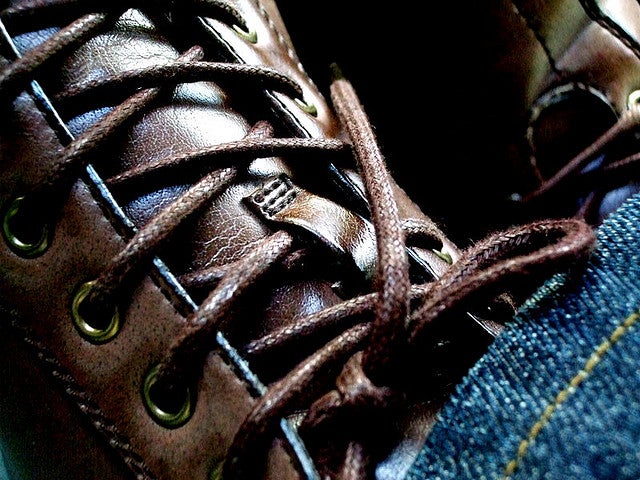Ontario Outdoors: How to Maintain Your Hiking Boots
AllOutdoor Staff 03.11.15

Now that you’ve found the right footwear and gotten the best fit and the best price, you’ve still got a few bases to cover to ensure the foundation of your Ontario hiking trip is sound! Footwear, like any other important piece of equipment, has to be maintained and configured to meet your needs. Why drop $200 on a nice pair of boots only to have the laces blow out and the seams leak muddy water on your toes? With these tips, we’ll help you maintain, customize, and trick out your footwear for maximum enjoyment.
Clean-Up and Dry Off
Contrary to popular belief, dirt is bad for boots! Of course, you can’t keep your boots in the box forever, so your best hope to prolong the life of your clompers is to keep them dry and remove the dirt occasionally.
After a short hike, knock the worst of the dirt off the boots against your stoop, remove the insole, and prop them up in a warm, dry place. If they’re soaked, a wad of dry newspaper inside will accelerate drying. DO NOT place them near a hot stove or heater. Melted boots = sadness.
After a long trip, you’ll need more intensive clean-up. Use a soft bristle brush and a hose to remove more of the surface dirt, scrubbing gently until the water runs clear. Be particularly gentle around the seams. Then, dry thoroughly in a warm place.
Decontaminate and Store Dry
My boots develop a “bouquet” after a long hike. Not only is the aroma eye-wateringly offensive, but it indicates I’ve stored my boots wet, which can degrade leather rapidly. After cleaning and drying the boot, give it the interior a spray with your favorite anti-fungal aerosol. Then, dump a box of baking soda into an old sock. Store each boot with one of these, and your boots will stay dry and (mostly) aroma free!
Goop Up
Many boots come with a factory-applied coating of “durable water repellent,” a compound that conditions the boot and helps it resist water. Adding a little more of this goop to your new boots is a great way to accelerate break-in and protect the footwear long term. After your initial break-in, you’ll want to re-apply this goop once or more per season. For my good boots, I’ll do a thorough goop-up at the beginning of the season, a touch up in the middle, and a very thorough goop-up at the end of the season.
Caring for Leather
If you’ve got a leather boot, you’ll need a treatment specially designed to condition leather. If your boot has any sort of waterproof-breathable membrane, make sure your treatment is compatible, or you’ll clog the pores in the membrane and lead to very, very sweaty feet.
To goop up leather, clean it thoroughly with a sort brush and water. Dry well and apply a thick coating of protectant, wiping off the excess. Exceptionally dry, cracked, or damaged leather might require repeat coatings. At the end of the season, I’ll leave plenty of excess on the leather to keep it hydrated in storage.
High End: For the ultimate protection and conditioning, try Obenauf’s Heavy Duty Leather Protectant. It’s a beeswax-based leather treatment designed for wildland firefighters, who literally bake their boots and submerge them in lye.
Middle-of-the-road: Nikwax Waterproofing Wax for Leather is a “water-based” wax solution that seems to strike in to wet or dry leather rapidly and effectively. This is my go-to goop for the vast majority of my boots.
It’ll work in a pinch: I’ve used a softened beeswax candle to waterproof and condition blasted-out boots in a pinch.
Caring for Fabric
Fabric boots need special treatments to soak into and protect the fibers. If your fabric footwear isn’t supposed to be waterproof, don’t expect a coating of goop to make it so. Instead, a bit of goop will keep dew or light moisture from immediately soaking through the boots and protect the fabric from swelling due to moisture infiltration.
High End: Nikwax Fabric & Leather Proof works to protect both fabric and leather footwear. Since it’s not very greasy, my preference is to use it on fabric boots
Middle-of-the-road: Grangers Performance Waterproofer seems to strike in well, but never seems to last me quite as long as the Nikwax. It’s certainly better than nothing!
It’ll work in a pinch: A brief spritz of an aerosle silicone waterproofing spray like Scotchguard works for a quick trip.
Trick Out Your Laces
Lacing can be the Achilles heel of a good pair of boots. Torn, slipping laces can make an awesome pair of boots fit poorly. So, consider upgrading your “factory” laces with an upgraded model.
High End: Rino laces appear to be the ultimate hiking boot lace. I’ve had some acquaintances rave about them, and they appear to resist fire and machetes in their promotional videos. I haven’t been able to justify spending $30 on a pair of shoelaces, but if I could, I would try these first!
Middle-of-the-road: Obenauf’s Industrial Strength boot laces have an exceptionally solid reputation, though they don’t claim to resist fire and machetes!
It’ll work in a pinch: Most cylindrical mens dress shoe laces are actually quite strong and sell for as little as $.99 a pair. Buy the longest possible, and you can even squeeze 4 laces out of a package.
Next week–come back for tips to optimize your foot health with the right socks, insoles, and other footwear accessories.